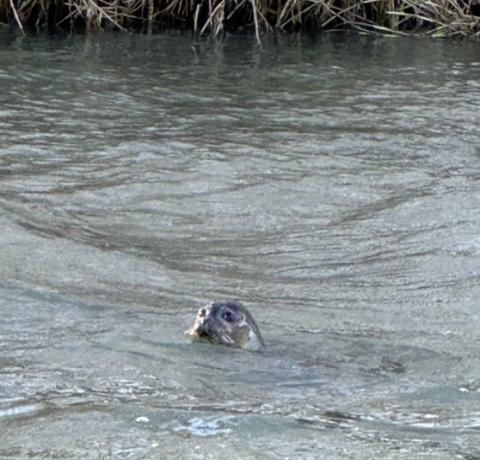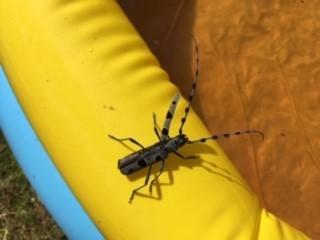
An unlikely combination but just a few of the unusual species seen across the county in the last few years, thanks to the curiosity of three Northamptonshire residents.
Seal
On the 17th January NBRC received an email reporting a seal that had been seen along a stretch of the River Nene, near Tansor (TL051911), north of Oundle. Believed to be a Common Seal (Phoca vitulina), the smaller of the two UK seals, it was seen by Samuel Wallace on the 15/01/2024.
Although we’d heard of there being records in neighbouring Bedfordshire and Cambridgeshire in the past, records for seals this far inland are obviously rare and this was the first known report of a seal seen in Northamptonshire. Along with many areas in the UK around this time Northamptonshire had experienced heavy rainfall and river levels were high with flooding in numerous areas and it was assumed this may be the underlying factor for the seal being in the area. Interestingly a Google search came up with an article by a Dr Mark Hows from a publication called Mammal News from Summer 2017 regarding seals in Cambridgeshire and perhaps makes the sighting a likely inevitable.
Cicada
Another first for Northamptonshire was a European Cicada (Cicada orni), seen back in 2022. On the afternoon of the 28th August, Martin Izzard and his wife were driving along the Polebrook to Oundle road when Martin heard what he thought sounded like a Cicada. Having heard them previously in other countries Martin was familiar with the sound. Although singing on and off, further investigation tracked the Cicada down to a Common Ash tree next to the road where it was at rest on the bark of the trunk.
Cicadas can be found in many places worldwide, Australia, New Zealand, Africa, North and South America and Europe with there being around 3,000 species. Only one species is known to be native in the UK, the New Forest Cicada (Cicadetta montana) but hasn’t been seen for 15+ years.
It’s thought the Cicada in this instance probably originated from soil at the nearby garden centre of Olive Grove, which at the time imported mature Olive trees and other Mediterranean plants.
Cerambycidae
With 73 species in the UK, a number of which will be found in Northamptonshire, it perhaps doesn’t immediately sound an unusual find. But, on the 24th June 2019, Sue Manning identified a large beetle in her Denford garden (SP9976) as being Rosalia alpina, a species from the longhorn beetles family (Cerambycidae). A quite stunning looking beetle with its light blue with black blotched elytra (wing cases) it appeared to have been attracted to the yellow-coloured paddling pool in her garden, where it was initially found within the water. Having a central European range there was understandably some immediate scepticism. Thankfully evidence is often key, and Susan photographed and videoed her discovery to support her record.
Many Cerambycidae are saproxylic, developing in soft and hardwood timber and although the source of this beetle is unknown it was believed by Tony Drane, county beetle recorder, to be from structural timber or furniture present in the area. The nearest timber merchants looks to be Thrapston
Many thanks to Samuel, Martin and Sue for reporting these records. You really do never quite know what you might find, and in my eyes is one of the joys of getting out and recording wildlife. There’s always likely something new to someone and fills that’s person with huge enjoyment when they see it. It’s a great feeling, even to just see that first of a species for the year….. I was extremely happy to see my first butterfly of the year recently, a Brimstone J
…What will the rest of 2024 have in store? Happy recording everyone!



